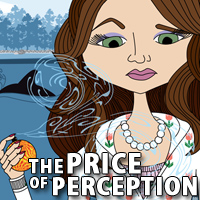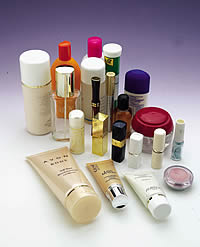 |
|---|
Courtesy of Teens for Safe Cosmetics
MARIN COUNTY—The photo of the group of teenagers shown on the Teens for Safe Cosmetics website could just as easily be an ad for a new MTV “Laguna Beach”-type reality show. The California girls in the photo are young, hip, stylish—not exactly whom you’d expect to see running a major campaign targeting some of the biggest cosmetic corporations for exposing their customers to toxic chemicals.
Marin County, California, where Teens for Safe Cosmetics is based, represents something of a public health enigma. At once one of the wealthiest counties in the United States and an area with an extremely high cancer rate, Marin offers proof positive that even the rich and privileged cannot afford to remain complacent about the environmental toxins that may be causing widespread cancer cases.
That’s where Teens for Safe Cosmetics and their parent organization, Search for the Cause, come in. While Search for the Cause aims to “investigate how exposures in our daily lives increase the risk of cancer,” Teens for Safe Cosmetics focuses particularly on spreading awareness among young people about the potentially carcinogenic ingredients found in many personal care and beauty products. And they’re forging their own fresh, innovative youth organizing tactics in the process.
A high price for beauty
“…from the time I got up in the morning to the time I went to bed I was probably using about 25 [beauty] products. Your skin is your body’s biggest organ, and 60 percent of what you put on your skin is absorbed back to your bloodstream.” |
Jessica Assaf, a 17-year-old junior at Branson School in Ross, California, is an activist with Teens for Safe Cosmetics who grew up in Marin County. Assaf says she was inspired to join the group at age 15 when she realized that “from the time I got up in the morning to the time I went to bed I was probably using about 25 [beauty] products.” In fact, according to the Teens for Cosmetics website, the average teen is exposed to about 200 chemicals a day through personal cosmetic products like eye shadow, mascara, and even shampoo and deodorant. “Your skin is your body’s biggest organ, and 60 percent of what you put on your skin is absorbed back to your bloodstream,” says Assaf.
The Food and Drug Administration, she says, “has no regulation on these products, there is no safety testing required. These huge companies can put basically any raw ingredient into the product.” Further, they are not required to list those ingredients. “I was just shocked to realize that these huge companies were getting away with putting toxic ingredients into the products,” she says.
Fighting for health
The Teens for Safe Cosmetics’ Dirty Dozen lists 12 toxic chemicals and the everyday products that contain them. Talc, for example, is a common chemical found in baby powder, deodorant and eye shadow. So what’s the problem? According to the Teens, talc is “a proven carcinogen” linked to ovarian cancer and lung tumors.
Petrolatum, another Dirty Dozen member, is a chemical found in many lotions, eye shadows and lipsticks, among other products. The Dirty Dozen entry states that petrolatum is “linked to cancer or other significant health problems” and has been banned by the European Union. In fact, says Assaf, the EU has banned over 1,100 chemicals. The U.S. government, however, has banned only nine.
With nationwide cancer rates soaring, Teens for Safe Cosmetics says these personal care products need federal regulation. And though the activists are young, they’re armed with the sharp political analysis, rhetoric and tactics to expose the guilty parties. “You put your trust into this 60-billion-dollar industry, yet you don’t even know what you’re putting into your body in these products,” Assaf says.
Project prom and beyond
| In January 2007, California became the first state to require manufacturers of cosmetic products to disclose the presence of any ingredient known to cause cancer or birth defects. |
In 2005, five Teens for Safe Cosmetics activists went to Sacramento to lobby for a new law that “would require that cosmetic companies report ingredients to the government.” And they eventually won: In January 2007, California became the first state to require manufacturers of cosmetic products to disclose the presence of any ingredient that is a chemical identified as causing cancer or birth defects. “It’s all about passion,” says Assaf. “Passion is power. We went into this state capital not knowing that the cosmetic industry had spent billions of dollars trying to make sure that we lost. But in the end the bill passed.”
Now, the group is embarking on a new kind of campaign, this time targeting one of the biggest nights of the year for cosmetic companies, as well as for teenagers: prom. “In that one night… you’re basically being exposed to hundreds of chemicals getting your makeup done, getting your nails and toes done,” says Assaf. But this prom season, the group is staking out the middle of Union Square, a shopping hub in central San Francisco where girls go for their pre-prom makeovers. There, they’ll set up a “green spa” where prom-goers can have their makeup done using natural products.
 The group hopes to fill the square with teens and adults wearing prom dresses, combat boots, and black lines under their eyes, looking “ready for combat” with the cosmetics industry. The idea, says Assaf, is to take the image of the prom queen and change her “into this educated woman who knew what she was putting into her body.”
The group hopes to fill the square with teens and adults wearing prom dresses, combat boots, and black lines under their eyes, looking “ready for combat” with the cosmetics industry. The idea, says Assaf, is to take the image of the prom queen and change her “into this educated woman who knew what she was putting into her body.”
Project Prom was partially inspired by an event that Teens for Safe Cosmetics participated in last summer targeting the popular OPI brand of nail polish, which contained phthalates, among the toxic chemicals on the Dirty Dozen list. Assaf describes this common nail polish ingredient as a major problem: In Marin County, “most of the women even get manicures and pedicures like once a week,” and salon workers are constantly exposed to the fumes.
In protest, safe-cosmetics activists wearing prom dresses with beauty queen sashes that read “Miss Treatment” passed out informational fliers on the Santa Monica promenade. In March 2007, the Los Angeles Times reported that OPI will remove phthalates from their products. “We looked like fools but I think that’s the time when we really changed things,” says Assaf.
“Green alternatives” and consumer power
 Though Teens for Safe Cosmetics and their allies can claim these victories, the battle against toxic chemicals has a long way to go. More than 500 cosmetic manufacturers have signed the Compact for Safe Cosmetics pledging to remove toxic ingredients from their products, but industry heavyweights—OPI, Avon, Estee Lauder, L’Oreal, Revlon, Procter & Gamble, and Unilever—have thus far refused to sign the agreement, according to the Campaign for Safe Cosmetics.
Though Teens for Safe Cosmetics and their allies can claim these victories, the battle against toxic chemicals has a long way to go. More than 500 cosmetic manufacturers have signed the Compact for Safe Cosmetics pledging to remove toxic ingredients from their products, but industry heavyweights—OPI, Avon, Estee Lauder, L’Oreal, Revlon, Procter & Gamble, and Unilever—have thus far refused to sign the agreement, according to the Campaign for Safe Cosmetics.
Until these chemicals have been completely eradicated from their personal care products, says Assaf, consumers should stick to the sometimes more expensive “green alternative” products. “If every person started buying the all-natural organic products, then the prices would drop significantly… It’s all in the consumers’ hands to make the price point available to any person.”
In the meantime, Teens for Safe Cosmetics continues to expand, and its members keep working to raise awareness in their own privileged community. “Everyone has a right to health and a right to know what we’re putting on our bodies,” says Assaf. “In the end, we shouldn’t have to choose our beauty over health.”




